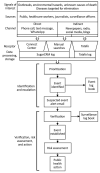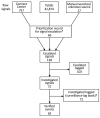Evaluation of National Event-Based Surveillance, Nigeria, 2016-2018
- PMID: 33622473
- PMCID: PMC7920654
- DOI: 10.3201/eid2703.200141
Evaluation of National Event-Based Surveillance, Nigeria, 2016-2018
Abstract
Nigeria Centres for Disease Control and Prevention established an event-based surveillance (EBS) system in 2016 to supplement traditional surveillance structures. The EBS system is comprised of an internet-based data mining tool and a call center. To evaluate the EBS system for usefulness, simplicity, acceptability, timeliness, and data quality, we performed a descriptive analysis of signals received during September 2017-June 2018. We used questionnaires, semistructured interviews, and direct observation to collect information from EBS staff. Amongst 43,631 raw signals detected, 138 (0.3%) were escalated; 63 (46%) of those were verified as events, including 25 Lassa fever outbreaks and 13 cholera outbreaks. Interviewees provided multiple examples of earlier outbreak detections but suggested notifications and logging could be improved to ensure action. EBS proved effective in detecting outbreaks, but we noted clear opportunities for efficiency gains. We recommend improving signal logging, standardizing processes, and revising outputs to ensure appropriate public health action.
Keywords: Lassa fever; Nigeria; bacteria; cholera; global health; internet; outbreaks; public health surveillance; viruses.
Figures


References
-
- World Health Organization. International health regulations (2005) [cited 2020 Aug 8]. https://www.who.int/ihr/publications/978924159
-
- United Nations Office for Coordination of Humanitarian Affairs. Africa Centres for Disease Control and Prevention and partners plan new approach to detect and respond to outbreaks: press release 21 Jun 2017. [cited 2020 Aug 8]. https://reliefweb.int/report/world/africa-centres-disease-control-and-pr...
Publication types
MeSH terms
LinkOut - more resources
Full Text Sources
Other Literature Sources
Miscellaneous

